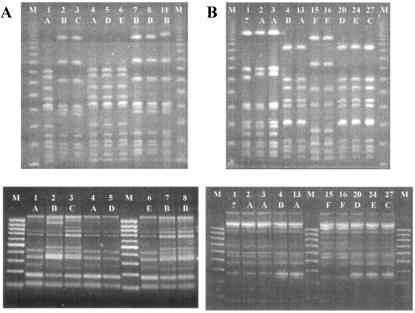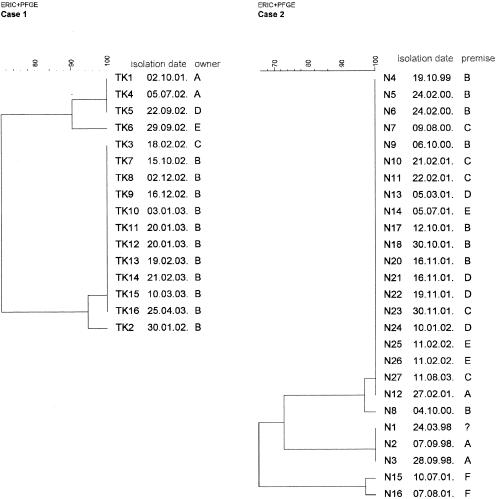Abstract
The present work describes two cases of consecutive fowl cholera outbreak series occurring in goose and turkey flocks. Most strains isolated from epidemiologically related outbreaks showed genetic relatedness, as revealed by enterobacterial repetitive intergenic consensus-PCR and pulsed-field gel electrophoresis, suggesting that the consecutive outbreaks were due to recurrences rather than reinfections.
Fowl cholera is an acute, fatal septicemic disease of various domestic and wild bird species, which is responsible for significant loss in poultry husbandry. Its causative agent, Pasteurella multocida, is a diverse organism; different genotype groups are implicated in different diseases, and genotype groups can also be paralleled with host preference (1, 8). P. multocida can be harbored in the respiratory tract or cloacal mucosa of asymptomatic birds, and these strains can become sources of outbreaks (5, 9). Wild birds and rats have been suggested as other possible sources of infection (2, 6) as well as contaminated water or aerosols (2, 10).
A number of DNA-based typing methods have been employed to characterize P. multocida strains (1, 4, 7, 8), but most authors concentrate on genetic diversity of P. multocida isolated from birds, and reports on genetic fingerprinting in tracing of fowl cholera outbreaks are scarce.
The present work studies two cases of serial outbreaks, one occurring in goose flocks kept by different owners in a relatively small geographic area and the other in turkey farms of a large-scale breeder.
Dead animals showed the pathognomonic signs of acute fowl cholera (abdominal hyperemia and subserosal hemorrhages and, in turkeys, pneumonia), and P. multocida was isolated from their organs. Identification was based on growth characteristics and biochemical activity and was confirmed by a P. multocida-specific PCR assay (13), which was also applied to determine the capsular serogroup of isolates. Antibiotic susceptibility testing was performed according to the CLSI (formerly NCCLS) disk diffusion method. We studied 16 (TK1 to TK16) and 27 (N1 to N27) isolates in cases 1 and 2, respectively. The numbering represents the chronological order of isolations.
For enterobacterial repetitive intergenic consensus-PCR (ERIC-PCR) bacterial genomic DNA was extracted by heat treatment at 98°C for 15 min. The PCR assay was performed in a Genecycler (Bio-Rad), using primers and PCR conditions described earlier (1).
Plugs for pulsed-field gel electrophoresis (PFGE) were prepared by mixing 4 × 108 cells with 1% low-melting-point agarose (Bio-Rad) containing 1% sodium lauryl sarcosyl sulfate and 1 mg/ml proteinase K (Sigma), followed by overnight lysing of cells in 100 mM EDTA containing 0.2% sodium deoxycholate, 1% sodium lauryl sarcosyl sulfate, and 1 mg/ml proteinase K. Plugs were digested with the enzyme ApaI (Promega) following the manufacturer's instructions. PFGE was performed in a CHEF-DRIII apparatus (Bio-Rad), in 1% pulsed-field certified agarose (Bio-Rad) at 14°C, at 6 V/cm, with a reorientation angle of 120°. Switch times were ramped between 5 and 30 s for 15 h and then 30 and 90 s for 7 h.
Banding patterns were analyzed with the Fingerprinting II software (Bio-Rad), using the Dice coefficient and the unweighted pair group method with averages. Genetic relationships were assessed using composite data analysis.
Case 1 was a cluster of fowl cholera outbreaks in geese grown for eiderdown production, kept confined by different owners but in the same village in southeastern Hungary. All isolates belonged to capsular serogroup A (data not shown) and were susceptible to penicillin, ceftiofur, trimethoprim-sulfamethoxazole, neomycin, and fluoroquinolones but resistant to nalidixic acid and tetracyclines.
Both DNA fingerprinting methods used revealed the presence of two genotype clusters (Fig. 1 and 2). The first cluster is composed of isolate TK1 (owner A), and isolates TK4 to TK6 (owners A, D, and E, respectively). The second cluster includes isolates TK2 and TK3 (owners B and C, respectively) and isolates TK7 to TK16 (owner B). Isolates TK2 (owner B) and TK6 (owner E), however, were slightly different from their respective clusters according to the software (Fig. 2). PFGE revealed a minor difference in the pattern of isolate TK11, probably representing a microevolution event (Fig. 1).
FIG. 1.
(A) PFGE (above) and ERIC-PCR (below) patterns of goose isolates from case 1. Lanes M, lambda concatemers (PFGE) or 100-bp ladder (ERIC-PCR). The numbers indicate the patterns of the respective isolates. Patterns of isolates TK9 and TK10 and TK12 to TK16 were identical to that of TK7 and TK8. The ERIC-PCR pattern of TK11 was also identical to that of TK7 and TK8. The letters below the numbers indicate the owner (see text). (B) PFGE (above) and ERIC-PCR (below) patterns of turkey isolates from case 2. Lanes M, lambda concatemers (PFGE) or 100-bp ladder (ERIC-PCR). The numbers indicate the patterns of the respective isolates. Patterns of isolates N5 to N12, N14, N17 to N19, N21 to N23, and N25 and N26 were identical to the patterns shown in lanes 4, 13, 20, 24, and 27, respectively. The letters below the numbers indicate the premise of origin (see text).
FIG. 2.
Composite dendrogram of isolates involved in case 1 and case 2. Dendrograms were constructed using similarities obtained both with PFGE and with ERIC-PCR using the Dice coefficient and the unweighted pair group clustering method with averages. Optimization was 1% for both PFGE and ERIC-PCR, while position tolerance was 2% and 3%, respectively.
Case 2 covers a large cluster of fowl cholera outbreaks in various flocks of adult turkeys. All flocks originated from the same hatchery and were kept confined as breeder stocks in different premises of the same company, in the Hortobágy region of eastern Hungary. Isolates N1 to N3, N15, and N16 belonged to capsular serogroup A, while all other isolates belonged to serogroup F (data not shown). All isolates were susceptible to penicillin, ceftiofur, trimethoprim-sulfamethoxazole, and tetracyclines, while they were uniformly resistant to neomycin and nalidixic acid. Isolates N1 to N8, N15, and N16 were susceptible to newer fluoroquinolones, but isolates N9 to N14 and N17 to N27 were resistant.
Results obtained with ERIC-PCR and PFGE were concordant, revealing three distinct clusters (Fig. 1 and 2), corresponding to the serotyping results. The first includes isolates N1 to N3. Isolates N2 and N3 originated from premise A, while the origin of isolate N1 is unknown. Isolate N2 was obtained from a hen with fowl cholera, which was kept at large on premise A. Isolates N4 to N14 and N17 to N27 form the second cluster. These originated from different premises (premises A to E) but not from premise F. The third cluster includes the only two isolates (N15 and N16) from premise F.
In both cases presented a given strain caused multiple consecutive outbreaks, as shown by repeated isolation of genetically related pasteurellae, similar to the findings of Muhairwa et al. (9). In case 1 consecutive outbreaks at the farm of owner B were due to highly related isolates; moreover, a related isolate was obtained from geese of owner C, indicating a possible spread of pasteurellae between owner B and owner C. Similarly, three isolates from birds of three other owners (owners A, D, and E) are also related, again suggesting exchange of pasteurellae between flocks of different owners. Pasteurellae from birds of owners B and C were unrelated to strains from birds of owners A, D, and E. PCR-based serotyping (13) was unable to detect this unrelatedness. To our knowledge no transportation of fodder or animals occurred between the owners; thus, direct contact of geese or cross-contamination can be excluded. The outbreak strain could have persisted in asymptomatic carriers, but this does not explain the genetic relatedness of isolates from birds of different owners. As these sites are in the same village, transmission might be due to wild animals, as described by Snipes et al. (11, 12).
In case 2 molecular fingerprinting indicated intracompany transmission, which was also found to be common by Carpenter et al. (3). As these premises are situated relatively far from each other (up to 40 kilometers), and the interval between different outbreaks reached 6 months, transmission by wild animals is unlikely. Transportation vehicles or fodder could be the means of transmission, but unfortunately these were not sampled. Interestingly, we observed the acquisition of fluoroquinolone resistance by isolate N9, which was detected in all consecutive isolates except for the unrelated isolates N15 and N16.
Molecular epidemiology investigations are extremely helpful in excluding reinfection and proving recurrence by detecting a known genotype in a recurrent outbreak, thus drawing attention to unnoticed persistence of pasteurellae. We can conclude that, in cases of successive outbreaks of fowl cholera, accurate typing of isolates can contribute considerably to the exploration of possible sources of pathogens, aiding the owners in preventing outbreak recurrences and consequently in eliminating severe loss.
Acknowledgments
We thank Éva Székely, Márta Antal, and Andrea Bistyák for their valuable help during the work and Tibor Farkas and László Sámi for their critical reading of the manuscript.
REFERENCES
- 1.Amonsin, A., J. F. Wellehan, L. L. Li, J. Laber, and V. Kapur. 2002. DNA fingerprinting of Pasteurella multocida recovered from avian sources. J. Clin. Microbiol. 40:3025-3031. [DOI] [PMC free article] [PubMed] [Google Scholar]
- 2.Botzler, R. G. 1991. Epizootiology of avian cholera in wildfowl. J. Wildl. Dis. 27:367-395. [DOI] [PubMed] [Google Scholar]
- 3.Carpenter, T. E., K. P. Snipes, R. W. Kasten, D. W. Hird, and D. C. Hirsh. 1991. Molecular epidemiology of Pasteurella multocida in turkeys. Am. J. Vet. Res. 52:1345-1349. [PubMed] [Google Scholar]
- 4.Chaslus-Dancla, E., M. C. Lesage-Decauses, S. Leroy-Setrin, J. L. Martel, P. Coudert, and J. P. Lafont. 1996. Validation of random amplified polymorphic DNA assays by ribotyping as tools for epidemiological surveys of Pasteurella from animals. Vet. Microbiol. 52:91-102. [DOI] [PubMed] [Google Scholar]
- 5.Curtis, P. E., and G. E. Ollerhead. 1981. Investigation to determine whether healthy chickens and turkeys are oral carriers of Pasteurella multocida. Vet. Rec. 108:206-207. [DOI] [PubMed] [Google Scholar]
- 6.Curtis, P. E. 1983. Transmission of Pasteurella multocida infection from the brown rat (Rattus norvegicus) to domestic poultry. Vet. Rec. 113:133-134. [DOI] [PubMed] [Google Scholar]
- 7.Huber, B. S., D. V. Allred, J. C. Carmen, D. D. Frame, D. G. Whiting, J. R. Cryan, T. R. Olson, P. J. Jackson, K. Hill, M. T. Laker, and R. A. Robison. 2002. Random amplified polymorphic DNA and amplified fragment length polymorphism analyses of Pasteurella multocida isolates from fatal fowl cholera infections. J. Clin. Microbiol. 40:2163-2168. [DOI] [PMC free article] [PubMed] [Google Scholar]
- 8.Hunt M. L., B. Adler, and K. M. Townsend. 2000. The molecular biology of Pasteurella multocida. Vet. Microbiol. 72:3-25. [DOI] [PubMed] [Google Scholar]
- 9.Muhairwa, A. P., J. P. Christensen, and M. Bisgaard. 2000. Investigations on the carrier rate of Pasteurella multocida in healthy commercial poultry flocks and flocks affected by fowl cholera. Avian Pathol. 29:133-142. [DOI] [PubMed] [Google Scholar]
- 10.Simensen, E., and L. D. Olson. 1980. Aerosol transmission of Pasteurella multocida in turkeys. Avian Dis. 24:1007-1010. [PubMed] [Google Scholar]
- 11.Snipes, K. P., D. C. Hirsh, R. W. Kasten, L. M. Hansen, D. W. Hird, T. E. Carpenter, and R. H. McCapes. 1989. Use of an rRNA probe and restriction endonuclease analysis to fingerprint Pasteurella multocida isolated from turkeys and wildlife. J. Clin. Microbiol. 27:1847-1853. [DOI] [PMC free article] [PubMed] [Google Scholar]
- 12.Snipes, K. P., D. C. Hirsh, R. W. Kasten, T. E. Carpenter, D. W. Hird, and R. H. McCapes. 1990. Homogeneity of characteristics of Pasteurella multocida isolated from turkeys and wildlife in California, 1985-88. Avian Dis. 34:315-320. [PubMed] [Google Scholar]
- 13.Townsend, K. M., J. D. Boyce, J. Y. Chung, A. J. Frost, and B. Adler. 2001. Genetic organization of Pasteurella multocida cap loci and development of a multiplex capsular PCR typing system. J. Clin. Microbiol. 39:924-929. [DOI] [PMC free article] [PubMed] [Google Scholar]




